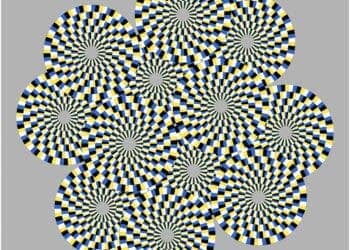Believe it or not, there’s no bulge in this image. It’s just a plain old checkerboard with some plain old M&Ms placed strategically. But that’s not what your mind sees, is it?

The bulge illusion and why it works
This mesmerizing photo wasn’t doctored in any way. The so-called “Bulge” illusion here was created by Mary Coffelt, Briena Heller, and Michael McCamy at the Barrow Neurological Institute in Phoenix laboratories by strategically placing white and purple M&Ms. The mix of color and shapes create the illusion that they bulge out. Cool stuff, right?
The illusion itself is attributed to Akiyoshi Kitaoka, the creator of several well-known illusions. It uses the fact that your brain tries to process information efficiently, but this can backfire in specific situations.
Our brains are wired to detect edges and contours—these are essential for recognizing shapes and understanding our environment. When the circular M&M disrupts the regular pattern of the checkerboard, your brain interprets this disruption as a change in the surface itself, leading you to perceive a bulge. The brain essentially “fills in” information based on the visual cues it receives, creating the illusion of a three-dimensional shape where there is none.
However, there’s another trick here: contrast. The stark difference between the dark and light squares of the checkerboard enhances the illusion by providing strong edges for the brain to latch onto. Essentially, your brain is a bit confused — it starts to think that maybe there’s a bulge, and then uses the contrast to justify that idea. Additionally, the lighting in the room can affect how you perceive the illusion. If the light source creates a shadow around the M&M, it can exaggerate the illusion, making the bulge seem more pronounced.
Reality is not what you think it is
The bulge illusion, like other optical illusions, highlights a fundamental aspect of how our brains work: they are not perfect cameras recording an objective reality. Instead, our brains are highly evolved organs that have developed shortcuts, or heuristics, to process vast amounts of visual information quickly. These shortcuts are generally helpful for navigating the world, but they can also lead to misinterpretations.
Your brain doesn’t process all the information; it doesn’t even have access to all the information. Basically, you’re constantly trying to make sense of incomplete information. In the natural world, a bulge or curve in a surface could indicate something important, like the presence of an object or a change in terrain. Thus, when your brain detects a disruption in a regular pattern, it might assume there’s a physical cause, such as a bulge, even when there isn’t one.
That’s why visual illusions like the bulge illusion are so important: they offer valuable insights into the nature of perception itself. They remind us that our experience of the world is not a direct reflection of reality, but rather a construction created by the brain. This understanding has broad implications, not only for psychology and neuroscience but also for fields like art, design, and even virtual reality.
If you’re not convinced, check out the video below to see how the bulge illusion “magically” disappears once you blow the M&Ms off.
Whether it’s an M&M or another object, the bulge illusion is a small but powerful example of how our minds shape the world we see.






